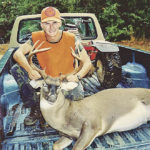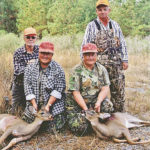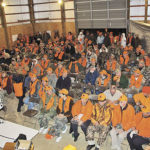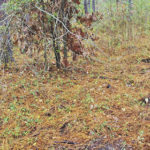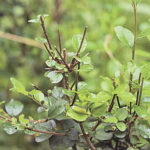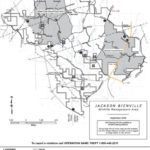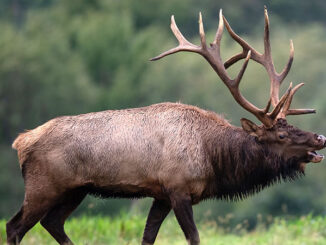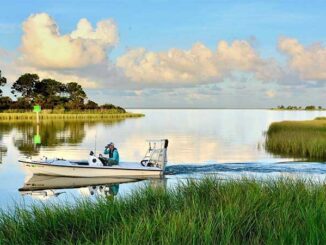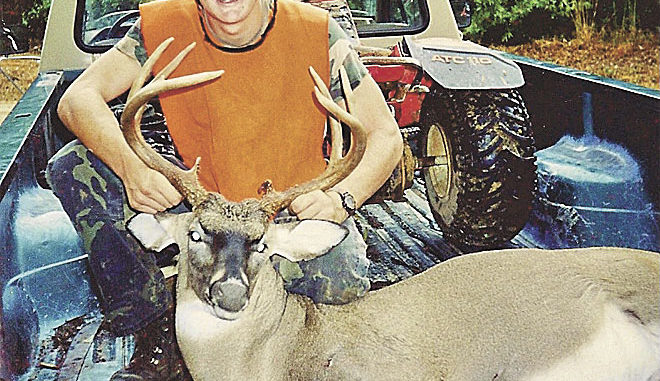
Has Jackson-Bienville WMA run out of deer? Hardly!
Jackson-Bienville is one of the oldest wildlife management areas in the state, and has had one of the most liberal deer harvest programs in the state, which makes some believe that this deer factory is out of deer. At the April Louisiana Wildlife & Fisheries Commission meeting in Baton Rouge, an individual made comments to the commission about the long either-sex deer season on Jackson-Bienville. He stated that the deer population is down because of this, and that there just are not enough deer to justify having such a long season.
He further commented that the long season is hurting the private clubs that surround the WMA, and hunters on the WMA are not tagging deer. Because of this, more deer are coming off the area than one can imagine, and there should be more enforcement to stop this.
I was involved with Jackson-Bienville for most of my wildlife career, and for the last three years have been making annual trips to the area during the deer season. One reason I have been hunting the area is because of all the deer sign I have found in the pine plantations that have been recently thinned. The deer browsing in these areas on privet, blackberry, verbena and honeysuckle has been some of the heaviest I have ever seen.
While listening to this gentleman speak, it was hard to imagine that there was a shortage of deer on the area. In the area I’ve been hunting, it is hard to take a step without seeing a plant that has not been browsed by deer.
Comments about no deer and too many doe days on the public areas are a common complaint heard during public meetings. I have found that hunters who have camps or lease nearby property do not want WMAs to have long either-sex seasons. Such seasons attract hunters from around the state, and this presents a problem for those who have a camp or tract of land nearby and hunt the areas on a regular basis.
Examination of the WMA harvest data reveals that fewer hunters are deer hunting on these areas than in the past. The deer harvest, however, has improved with a much greater kill per hunter effort now than what it was 40 years ago. The average deer kill per hunter effort was one deer per 22 hunter efforts in the 1970s, and today it is one deer per 11 hunter efforts.
The harvest rate is much higher than in the past so there must be some deer on these WMAs.
History and mangement
Jackson-Bienville was first leased for a Game Management Area in 1951, when it was about 15,500 acres in size. The 1952-53 Biennial Report of the Wildlife and Fisheries Commission mentions that 40 does from Madison Parish were released on the area even though there were some native deer present on this mixed pine/hardwood habitat.
Deer hunting did not occur until 1957. This was a short, bucks-only season that resulted in a kill of 97 bucks.
The report also noted that more than 100 game-farm turkeys had been released on the area, but little reproduction from the birds had been found. The program of releasing game-farm quail and turkeys was a waste of time and money.
The first either-sex deer hunt was held during the 1958-59 season, and resulted in a total harvest of 325 deer. The 1960-61 LWFC Biennial Report notes that the deer range was being over-browsed, and that more deer needed to be harvested from the area.
It is important to note that there was very little timber management being done on the area at this time. The area was a mature forest, and high deer numbers were probably over-browsing available habitat.
During the 1960s, the annual deer harvest remained relatively low. It was believed by biologists that the annual loss of deer from unknown causes was higher than the hunter harvest. A study was initiated in 1971 to determine if there was a large number of deer dying from natural mortality. The study was somewhat complicated and could not determine the exact natural mortality, but it did show that there were deer dying from unknown causes.
The Game Division moved forward with a new five-year harvest program for the area to determine the maximum legal harvest that could be obtained from the area. The either-sex season was increased to 25 days. Hunters were required to obtain daily permits, and all harvested deer were checked by division personnel.
There were 19,163 hunter efforts during the first year of the study, and the harvest was 699 deer. Unfortunately, the annual hunter effort declined during the next four years, as did the deer harvest.
Another problem for the study was the fact that logging began on the area, creating more browse and cover for the deer. There were also a couple of years of heavy rainfall during the hunts, which limited the ability of hunters to get around on the area. It is generally best to keep all factors the same during a research study.
Declining hunter effort, increased timber management and poor weather kept the study from producing conclusive results; however, there was improvement to the deer herd and habitat. The deer herd was not eliminated by the heavy hunting pressure, although many believed the deer herd had been significantly reduced. There was even concern by some of the biological staff about too much either-sex hunting.
When Willamette Industries purchased the WMA, the timber program really accelerated. The word clear- cut became a common phrase during the 1970s. While doing my graduate work in Bienville Parish, it was amazing to drive from Monroe and travel throughout the parish, and see the logging that had occurred on a weekly basis.
The increased browse and cover that results from a clear-cut will usually result in an increased population of deer.
The deer harvest for the area remained relatively stable, fluctuating with the hunter turn-out and the weather conditions. Jackson-Bienville was now 32,000 acres in size.
Another change in the deer season schedule for the 1991-92 season resulted in a hunter effort of 9,250 and a kill of 554 deer. Body weights of deer were better than those documented in past years. Yearling bucks now weighed about 130 pounds, whereas in 1957 they were 114 pounds.
During the 1990s, the self-clearing permit station program was initiated, and harvest data on Jackson-Bienville was obtained only from the two managed hunt days.
During the 2007-08 season, the area was open for either-sex hunting during the entire season; the reported harvest was 360 deer.
During the 2008-09 season, the reported harvest was 378 deer.
The 2009-10 season will be either-sex during the entire gun season also.
Where to hunt
Steve Hebert, the Region 1 Wildlife manager, told a story two years ago about a man who had never hunted on Jackson-Bienville, and had asked him where would be a good place to hunt. Hebert was working the Ansley Check Station, and told him to just drive into the area about a mile or so and hunt the woods on the left. The man came back about an hour later with a nice 1½-year-old buck.
It is not quite that easy, but there is good deer hunting on JB pretty much throughout the area.
The main reason for this is the timber management being applied by Weyerhaeuser (who purchased the area from Willamette). Alan Boyd, a forester/manager for Weyerhaeuser, has been involved with the timber management on JB for many years, and conducted a survey of hunters a few years ago, asking them where they like to hunt.
The No. 1 answer was the hardwood drains. Despite the intense pine management on the area, there is still a lot of hardwoods that produce mast for the deer. The Dugdemona River runs midway through the area, north to south. Madden Creek, Redwine Creek, Cypress Creek, Choctaw Creek and Caney Creek are a few of the other tributaries on the area.
Over the years, we have examined deer stomachs during the managed hunts, and there is generally high use of acorns during the early November hunt days. No doubt bowhunters take advantage of the mast crop during October and early November.
Cow oaks and white oaks are common trees on the area, and are preferred by deer. There are also plenty of water oak trees in these drains. Add in some other red oaks species such as the black oak, and one can see that there is good diversity of oaks for hunters to set up on.
One way to determine what the current mast crop is like is to drive to the field office and check-out the oak trees around it. If those white oaks and black oaks have acorns, the odds are there will be acorns throughout the area.
There are also feral hogs on the area, and hunters know they regularly travel the hardwood drains in search of good mast.
The second-most popular hunting location was on food plots or planted rights-of-way. In the past, the department has done a lot of planting on the areas, and these green patches and lanes are readily used by deer and provide good hunting locations.
Recent budget issues have created problems for planting, so these areas may not be planted every year. They generally do get bush-hogged, and the native herbaceous plant species that grow in these openings will attract deer also. Following the bush-hogging in the fall, many of these sites will have clover and winter grass regeneration from seed produced in the spring and early summer, providing winter forage for deer and sites for hunters.
The thinned pine plantations came in third, and also provide good hunting opportunity. Some plantations have been sprayed with herbicides, so it is always good to do some scouting prior to deer season. A treated clear-cut will not have the browse diversity like one that has not been treated.
A thinned plantation with a streamside zone running through it is always a good location since it provides both mast and browse, as well as escape cover. Some of the plantations that have been thinned have been fertilized, and the plant growth of some browse species is exceptional.
I hunted a thinned plantation in 2006, and killed a spike that weighed 135 pounds, an excellent body weight for a young deer. There are also areas that have been cleared for the red-cockaded woodpecker colonies, and these open areas provide a location for deer hunting. Boyd does ask that hunters not set-up next to a nest tree because the bird might be scared off at dusk and have to roost on a limb in the open and that would make it subject to predation from owls.
Jackson-Bienville also has a strong population of feral hogs, and hunters are encouraged to harvest them. There is no daily limit on hogs. The hardwood drains are good areas to locate hogs, but hogs can also be found in the thinned pine plantations rooting through the piles of debris left from the thinnings. Of course hogs, can be regularly found in the planted areas, which is one reason they are such a pest.
When to hunt
Jackson-Bienville opens the weekend before Thanksgiving, ahead of the traditional managed hunts on most areas. Because of this, JB is often the second stop for the WMA circuit hunters who travel the state and take advantage of the hunting on public lands.
The rut on JB is not like that of Area 2, which typically has a late October/early November first peak of breeding activity. The stocking made with deer from the Mississippi Delta genetics has created a later rut, usually mid to late December. Hunters who want to hunt the rut need to come before or during the Christmas holidays.
I hunted the area last year the week before Christmas. It was somewhat wet and cool, and deer movement was not good. We found some fresh scrapes and rubs, but did not encounter the deer that made them. I believe the rut came after Christmas last year; however, Eric LaComb of Sulphur connected with a good 210-pound adult buck on Dec. 9. The buck had good mass, and was bedded down with a doe. This was LaComb’s first hunt on Jackson-Bienville (he hunts other public lands).
On Dec. 28, Tony Kline killed a 12-pointer with a 21-inch inside spread that weighed 227 pounds empty. This is an example of the big bucks that JB produces and that hunters have a chance for during the peak of the rut.
The typical adult buck (3½ or older) is generally a good 8-pointer with a 16-inch inside spread and weighing around 200 pounds. Last year during the November hunts, there were four older adult bucks killed that averaged 210 pounds. The really large bucks, like the one Kline killed, are harvested during the rut, and LDWF does not get the statistics from most of them. The department would certainly appreciate all information and photographs that hunters would provide to them.
The 2009 hunts will require hunters to use self-clearing permits, and all harvested deer must be tagged with the hunters’ license tags. Hunters must follow procedure to report and validate their harvests on JB, using the phone or internet reporting system. A hunter’s orange hat and vest are required of all deer hunters. There are also regulations pertaining to ATVs, retrieval of dead deer and a few other regulations specific to JB so be sure you read the 2009-10 Regulations Book.
